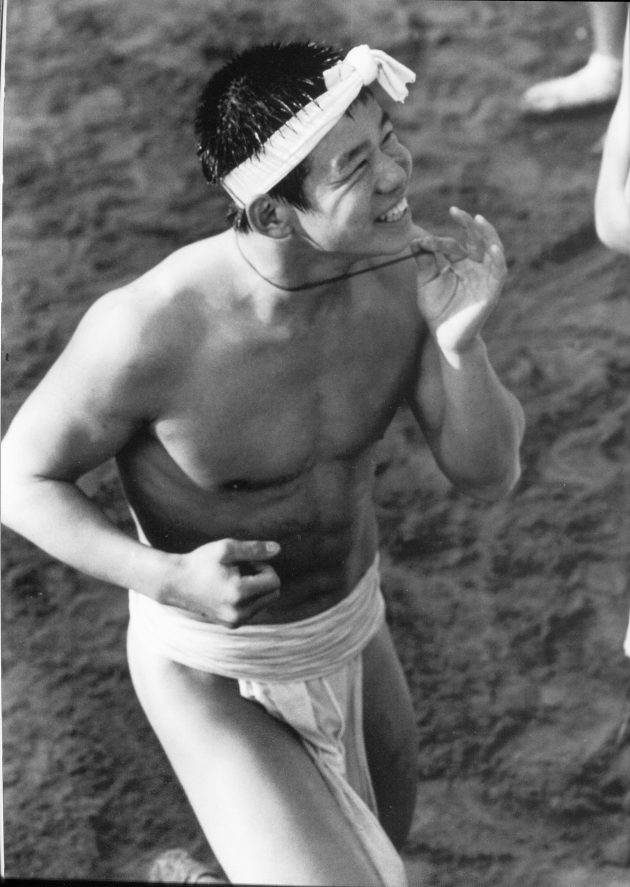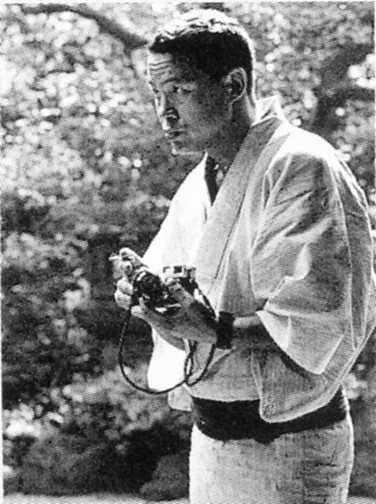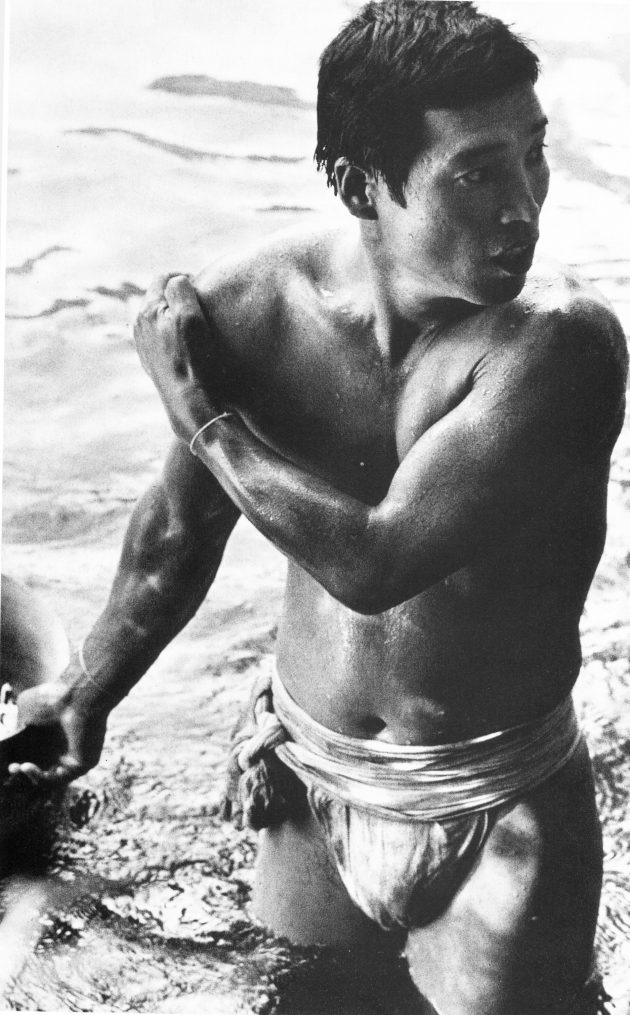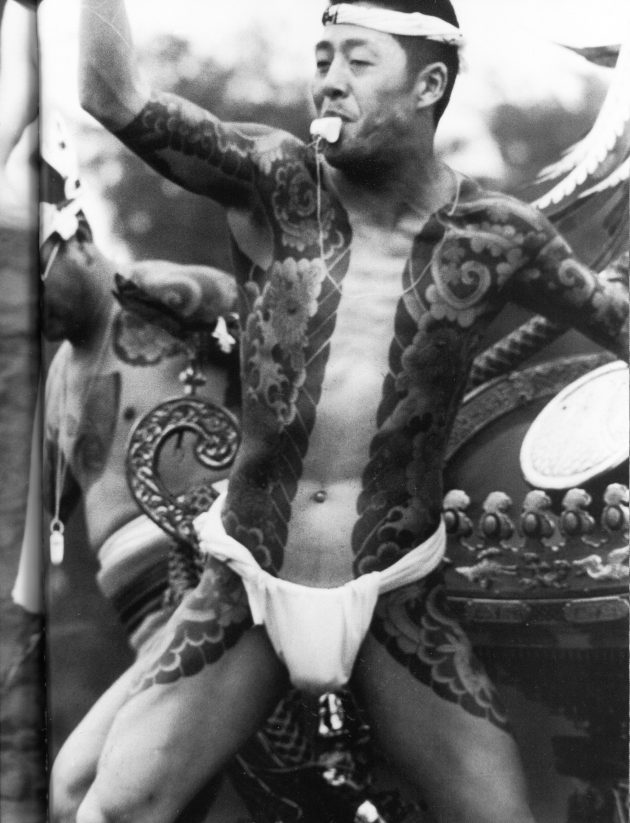
In the preface to his 1972 collection Otoko, Tamotsu Yato wrote that “when these young men stand before my camera I never find in their nudity the slightest trace of vulgarity or coarseness. Instead, it is a thrilling moment that arouses in me much the same emotions as those I feel when I see a perfect fruit just fresh from the tree, or a brand-new expensive camera still in the shop window.”
“Later,” he continues, “you bite into the fruit and find the taste less than you expected, use the camera and find again how far short execution falls of conception. Yet, there was that thrilling moment.” And in the young men standing before his camera there is that fleeting instant when “we see that nudity can be . . . totally free of that element of shame that usually accompanies it. Indeed, this would have been clearer yet if Japan’s antiquated censorship laws had not stood in my way.”

Born in Nishinomiya in 1928, dead in Tokyo in 1973, Tamotsu Takeda (Yato was his geimeai) was an extraordinary photographer whose work has never received the acclaim that it deserves. In his short life he published only three collections: Young Samurai: Body Builders of Japan, 1967; Naked Festival, 1968, and Otoko: Photo-Studies of the Young Japanese Male, 1972, and this comparatively slim output is one of the reasons for his neglect.
Another is that he was self-taught, and never entered into any of the many photographic clubs and organizations which exist in order to publicize members’ work. His pictures did not appear in the journals and he knew no one influential enough to help him attain the reputation he deserved.
Yet another reason, and perhaps the determining one, is the photographer’s subject matter. It was exclusively the young male nude. Many photographers have, of course, gone on to fame and fortune by specializing in the young female nude but it is only recently that equally naked males have become equally respectable. And not everywhere. In Japan the nude male is still regarded with a degree of suspicion.

This is curious, given Japan’s tradition of natural male nudity. It long continued and though Meiji authorities were continually trying to cover it up, the very number of their prohibitions indicates the prevalence and the stubbornness of the resistance. The reasons for the clean-up are apparent. Western ideas of respectability were loose in the land and the upwardly social mobile had to be dressed. Though the West has now turned as nude as the “natives” it once criticized, the Japanese authorities remain well within the Meiji era.
Even now, after the so-called hair barrier has been breached and pubic hair is allowable in public publications, it is only the female variety that is permitted. This is because women are still not deemed important enough to embody respectability — they, the aboriginals on television, animals, these are allowed to be naked. Men, however, are another matter.
Japan, still constructing masculinity, continues to see nudity as demeaning. It is associated with the working classes, and its display of human vulnerability is disturbing to macho ambitions. When clothes become social badges (and they always do) then the more the better. What is to be feared is that clotheless state which implies equality.
Yet there remains in Japan a single reminder of a prior naturalness, something which still exists from pre-Western days. This is the hadaka matsuri, the naked festival, the yearly event where the male nude becomes suddenly respectable.* Though there have been many attempts at eradicating this event, all have been unsuccessful. It is still here, marginalized into a tourist event or otherwise ghettoized though it be. The reason given is that it is a religious observance — and so it certainly is.
Yato’s extraordinary collection of photographs is thus, among other things, a record of Shinto events which puts social nudity in its proper place — as an integral part of that giving of self which is the act of faith. The sacredotal (to say nothing of the anthropological) value of the collection is enormous. There has never been anything like it and it is unlikely that there will again be — the balance between the photographer and his subject was that precise.
So, in looking at these pictures, we might well trace this impulse which I will call religious, through the spectrum of the photographer himself and find in it the identity which makes this collection so rewarding and which makes Yato such a truly singular photographer.
Yato wrote that “even the toughest, roughest of youths, when stripped bare of all their clothing, seem somehow defenseless, piteous. There is an air about them of being dependent upon something outside themselves, of wanting to bow down to some external power. This is a quality peculiar to these short years between boyhood and full manhood. During this time it is as though the very fragility of their existence is mingled with awe of the unknown. It is a suspense-filled moment in which they seem to teeter between the belief that something wonderful is growing within themselves and a secret premonition that all their hopes will one day come to nothing.”
He was, to be sure, not speaking of the men in Naked Festival but the men in Otoko, that publication which enshrines (there is no other term) the young male nude. Nonetheless, it is true that all nakedness implies a kind of defenselessness though this is not all that nudity implies.
When you look at someone naked you are given a choice. You may find them sexy or you can find them pathetic. The choice depends upon the viewer, not the subject. No one would find the Auschwitz unclothed sexy, and few would find the Playboy unclothed anything else. You may find a clothing-challenged person an object of desire, in which case you even further objectify that object by calling it a nude. Or, you may find the same person an object of concern in which you subjectify your closeness and prefer the pathetic term, naked.
Or you may combine the two into a single gaze. This is what artists do. Kenneth Clarke in his seminal study, The Nude, said that if the work of nude art did not sponsor an arousal it was not then very good art. At the same time, however, if arousal is all it accomplished then it may not be art at all. The balance between object and subject, between corn-modification and empathy, is crucial.
One of qualities of Yato’s Naked Festival is that while the pictures offer an objective, indeed, near anthropological record of the rites of naked festivals, the participants are at the same time eroticized, that is, their erotics are emphasized. This fact one may test for oneself by examining most other Japanese photographic records of naked festivals. How clinical most seem, how academic. It is this double vision (the human condition plus desire) that so informs Yato’s collection.

To take a photography — shashin o toru. To take means to get hold of, to grip, grasp. This means, says the dictionary, to secure by winning, to seize and affect, to catch by trapping or snaring. Such competitive overtones then accompany picture-taking, that activity so popular and so pleasant.
Whatever else he may be doing the photographer is also, insists the verb, seizing. Taking a picture is thus an aggressive action which aims at capture. And once taken, the image belongs to the photographer.
While this is to an extent true of all photographs, it is largely true of nude photographs. The naked body, male or female, once photographed, has an air of having been captured. There is in every nude photo the feeling of enclosure. If the photo is taken with the nude subject unaware, the background becomes a reservation, a wide but closed area. If the nude is aware then she or he becomes a model and the area is further restricted — a closed room, a cell. To be naked is perhaps to be free but the naked observed is no longer free.
She or he has become objectified, a thing, chattel to the viewer. This is the satisfaction of the voyeur, this turning of another human into something else, whether he carries a camera or not. And this is the reason that photographed nudes often look so anonymous — the specific becomes general, the individual becomes a type.
The male photographer who takes female nudes we take for granted. Cultural roles call for the subjecting male and the subjected female. Categories (girlie pix, cheese-cake, spread beaver) so affirm this attitude that we rarely remark upon it. But the male photographer who takes male nudes seems suddenly to display a naked aggression.
This is because culturally determined male rivalry never takes this apparent a form. The subjecting of one male to the will of another occurs, of course, constantly in Japanese as well as other societies, but it does not often occur on so overt a level. The picture of a naked man taken by a man calls attention to itself, to his defenselessness, and to the rapaciousness of the lens.
To show a man nude is to show him as a child again, naked and defenseless. Though he may be powerful, with bulging muscles, he exudes hapless adolescence. The naked woman on the other hand, even if she is very young, is found to exude maturity. Cultural roles have decided that the nude female becomes something more than she is, the nude male something less. One laughs at a naked man. One never laughs at a naked woman.
Too, the category of the female nude is so common that its appeal has been accepted, internalized, domesticated. Nude males, however, are much less common. Consequently their image retains an ability to disturb. It suggests subjugation, availability — yet it is not in the slightest female, a category in which such qualities might be found unobjectionable. It can only mean the regarding of one man by another as sexual object. A result is that photographs of naked women are never called merely heterosexual while photographs of naked men are never called anything other than homosexual.

Yato embodied the erotic gaze — he was one of the earliest to do so openly. At the same time the gaze involved much more than simple erotics and it is this, no less, which merits our attention.
One might begin by wondering at why being naked should in itself constitute a festival. One answer is supplied by Yukio Mishima in a passage (elsewhere given in full in this portfolio) where he speaks of the unity of sacred nakedness, of “the sanctity of the flesh.” As a possible reason one might then mention that all naked festivals in Japan are competitive in nature.
Though there may be unity in the processions to the site, and in the concluding rites themselves, the ritual is given over to an often violent competition. Violent and ideal in its way because the competitors are equal as they never are in secular life. There is no visible advantage of class, of status, in accouterments, in clothing — they are all naked.
Their context is homosocial (not homosexual) and it is within this all-male world that the participants strive against each other to obtain, in some form or other, the favor of the deity. Though other countries have this kind of competitive festivity it seems there less exclusively contentious than it does in Japan. Perhaps this is because competition is so near the surface in such a chronically overcrowded island. So near that modern society has had to invent such concepts as an innate wa, a natural accord, simply in order to contain within it a natural animosity. Nakedness in its way validates strife because those stridations of status designed to suppress it are completely removed.
One naked man strives against another. One will win and the loser become lesser. And all this occurs under the eyes of the god — it is for this gaze that the rite is performed. (In practice this does not occur in the hadaka matsuri and in any case the individual has usually become the team anyway; losers pay no penalty — the whole thing might be called an exhibition match).
But there is another gaze as well — that of the photographer. Sacred nudity is there, and desire as well (those well-lit butts, those crotch-shots, the emphasis on the fundoshi and by implication what is under it) but this is also an impartial gaze. The grace of the human form, the turn of a head, the unconscious and natural dignity of a gesture, this the photographer also gazes upon. And, though these men are made objects through desire, their subjective selves are also insisted upon — each so exuberantly precarious, so willingly uncomfortable. So intent is each member to submerge himself in this mass that it is, perhaps paradoxically, the singular personality that the camera reaches and reveals.
In keeping with this double vision, one so native to him that he probably never thought of it, Yato goes through an adult erotics to return to something like an adolescent innocence. He tells us something about himself but also about the human condition, and by doing so he tells us something about ourselves.
I KNEW YATO very well, from shortly after he had come to Tokyo from Osaka and before he became a photographer. He had been a day laborer, worked at Nichigeki, been a flamenco amateur, a bit player at Nikkatsu Studios, became a body builder. It was Meredith Weatherby, president of the Weatherhill publishing house, who bought Tamotsu his first camera and whose friends showed him how to use it. It was through Meredith that Tamotsu met those who encouraged him, Yukio Mishima among them.
During this time I was able to view the rapid growth of Tamotsu’s talent. We lived together in that big farmhouse that Meredith had re-erected near the Roppongi crossing. He and Tamotsu had the downstairs rooms and I had a place on the second floor. Tamotsu photographed every day and with each new contact sheet we could watch him seeing deeper, capturing more. Mishima, a frequent visitor at the house, was particularly encouraging and it is not too much to find that his vision — as seen in his novels, essays, plays — helped form Tamotsu. With his growing talent, the photographer’s confidence and dedication deepened — resulting in his extraordinary travels which led to the collection of more than two thousand negatives from which Naked Festival was culled.
But nothing lasts. Our living arrangement did not. Tamotsu went elsewhere to live, as did I. Meredith eventually retired to San Diego, where he died. And that beautiful farm house and its garden were razed and the plot is at present a parking lot.
Tamotsu, by now forty-five years old, lived in an apartment in Takadanobaba, experimented with color photography, and on the night before we were to meet to go, as we always did, to the Sanja Matsuri in Asakusa on the last weekend in May, he died in his sleep. The doctor had told him that he had an enlarged heart and the coroner said that this had killed him. The service was held at a small temple next to the Weatherby house and Tamotsu’s remains are in the family plot at Nishinomiya.
His negatives were taken by Meredith to California and after his own death they passed into the hands of Fumio Mizuno, who now owns them. It is with his kind permission that this selection is here reprinted.
* Hadaka, the Japanese word for “nakedness.” has a wider connotation than the English word. It can apply equally well to complete nudity and to a partial state of undress. To the Japanese, the fundoshi or loincloth is hardly an article of clothing at all. but more an essential attribute of nakedness. —Takahashi Mutsuro. “The Japanese Loincloth”
This article appeared in KJ 44, published in July 2000, together with Donald Richie’s ‘Tadashi Nakajima’ and Yukio Mishima’s ‘On Nakedness and Shame,’ together with 25 pages of Tamotsu’s photographs.

Donald Richie (1924–2013) first came to Japan while serving with the US military in 1947. Fascinated by Japanese culture, he became well known for his writings on Japan spanning 50 years, especially on Japanese cinema. His more than 40 books include The Inland Sea, and Public People, Private People, and two collections of essays on Japan: A Lateral View and Partial Views. The Donald Richie Reader. The Japan Journals: 1947-2004 was edited by Leza Lowitz. See interview ‘Freedom within Bounds’ by Janet Pocorobba, KJ 41.
Sacred Desire: Notes on Tamotsu Yato, photographer – Yukio Mishima Naked Festival –Photographs by Tamotsu Yato
Advertise in Kyoto Journal! See our print, digital and online advertising rates.
Recipient of the Commissioner’s Award of the Japanese Cultural Affairs Agency 2013